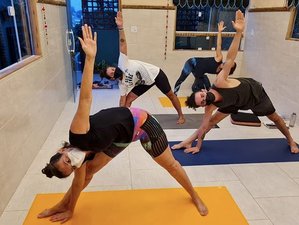
Many people have asked "What is power yoga?" Power yoga is an exercise which uses the principles and practices of karma yoga. It has been practiced for over 5000 years, and its many benefits range from mental clarity to increased flexibility. As a form of exercise, power yogi practices focus is key to being successful. This discipline encourages focus and positive attitudes, which can lead to greater physical and mental fitness.
Power yoga doesn't require weights. Instead, the body is asked to maintain its own weight while performing the poses. This results in increased muscle tone. This is a great cardio workout. Additionally, a stronger muscle tone can help burn more calories even if you are not exercising. This exercise may be beneficial to those at high risk for obesity and those who binge eat frequently. It may help reduce joint and back pain and encourage people with these conditions to become more active. It reduces stress and tension and can be used to aid in relaxation and better sleeping.

If you're new to yoga, the most important thing to remember is that power yoga is not like traditional yoga. This practice can be quite challenging but it will bring you many benefits. This workout can be more intense and help you lose weight or build muscle. You can also improve your health by doing it. For those who suffer from insomnia, a power yoga teacher is recommended. A qualified instructor can help you to develop a routine and get maximum results.
Power yoga can be a great cardio exercise. The practice of yoga helps people improve their immune system, which means that they'll have a more powerful immune system. This is a great exercise to lose weight and help you improve your overall well-being. Regular high-intensity and moderate exercise is key to achieving the results you desire. You will burn more calories the more you exercise.
One of the most important benefits of power Yoga is its ability boost your metabolism. This type of yoga will increase your body’s energy level and help you lose fat faster. Power yoga is a great way to reduce stress and get a better nights sleep. Power yoga is an effective way to fall asleep. Power yoga will not only improve your mood but also give you better sleep.

One of the biggest benefits of power yoga is better overall health. Power yoga can improve your overall health, give you a better nights sleep, boost your immunity system, and lower your chances of getting sick. By incorporating power yoga into your weekly routine, you'll be able to see results more quickly and experience better sleep and general wellbeing. You can also lose weight with power yoga. Make sure you're in good health before you begin any exercise.
FAQ
What are 5 ways to live a healthy lifestyle?
Healthy living means eating right, exercising regularly and getting enough sleep. It also involves managing stress and having fun. Avoiding sugar and processed foods is key to eating well. Exercise burns calories and strengthens the muscles. Getting enough sleep improves memory and concentration. Stress management reduces anxiety, depression and other symptoms. Fun is the key to keeping us healthy and happy.
What is the difference between a calorie or a kilocalorie.
Calories measure the energy content of food. Calories is the unit of measurement. One calorie represents the energy required to raise one gram of water's temperature by one degree Celsius.
Kilocalories are another way to describe calories. Kilocalories equal one thousandth of a calorie. 1000 calories equals 1 kilocalorie.
Why does our weight change as we get older?
How do you know if your bodyweight changes?
If there are less calories than muscle mass, then weight loss is possible. This means that daily calories should be less than daily energy. Reduced activity is the leading cause of weight gain. Other reasons include poor eating habits, stress, hormone imbalances, certain medications and illness. Weight gain occurs when there is more fat than muscle mass. It occurs when people consume more calories each day than they use. It can be caused by overeating or increased physical activity as well hormonal changes.
We eat less calories than we burn, which is the main reason our bodies lose weight. When we exercise regularly, we increase our metabolism rate which burns off more calories throughout the day. This doesn't necessarily mean we will lose weight. What matters is whether we are losing fat or building muscle. Weight loss is possible if you burn more calories than you consume. But, if we consume far more calories than what we burn, then we actually store them as fat.
As we age, our ability to move around is slower and we are less mobile. We also tend to eat less food than we did when we were younger. As a result, we gain weight. On the flipside, we are more muscular than we really need and appear bigger.
Without regularly weighing yourself, it is impossible to gauge how much weight you have lost. There are many different ways to measure your weight. You can check your waist size, your hips, your thighs, your arms, etc. Some prefer to use bathroom scales, while others prefer tape measures.
For a better track of your progress, try to weigh yourself once per week and measure your waistline once every month. To see how far you have come, you can take photos of yourself every few month.
Online, you can find out your height and weight. If you're tall at 5'10", and weigh 180lbs, your weight would be 180.
Statistics
- WHO recommends consuming less than 5% of total energy intake for additional health benefits. (who.int)
- nutrients.[17]X Research sourceWhole grains to try include: 100% whole wheat pasta and bread, brown rice, whole grain oats, farro, millet, quinoa, and barley. (wikihow.com)
- The Dietary Guidelines for Americans recommend keeping added sugar intake below 10% of your daily calorie intake, while the World Health Organization recommends slashing added sugars to 5% or less of your daily calories for optimal health (59Trusted (healthline.com)
- Extra virgin olive oil may benefit heart health, as people who consume it have a lower risk for dying from heart attacks and strokes according to some evidence (57Trusted Source (healthline.com)
External Links
How To
What does "vitamin" actually mean?
Vitamins can be described as organic compounds found in food. Vitamins aid us in absorbing nutrients from the food we eat. The body cannot make vitamins; therefore, they must be obtained from food.
There are two types: water-soluble and fat-soluble vitamins. Water-soluble vitamins dissolve readily in water. These include vitamin C (thiamine), Vitamin B1 (riboflavin), Vitamin B2 (riboflavin), Vitamin B3 (niacin), Vitamin B6 (pyridoxine), Vitamin C, B1 (thiamine), Vitamin B2 (riboflavin), Vitamin B3 (niacin), and Vitamin B6 (pyridoxine). The liver and fat soluble vitamins are stored within the liver and in fatty tissue. Vitamin D, E, K and A are some examples.
Vitamins can be classified according to biological activity. There are eight major vitamin groups:
-
A – Essential for normal growth, and the maintenance of good health.
-
C - important for proper nerve function and energy production.
-
D - Vital for healthy bones and teeth
-
E is necessary for good vision, reproduction.
-
K - required for healthy muscles and nerves.
-
P - vital for building strong bones andteeth.
-
Q - aids digestion and absorption of iron.
-
R - Red blood cells are made from red blood cells.
The recommended daily allowance of vitamins (RDA), varies according to age, gender, physical condition, and other factors. The U.S. Food and Drug Administration, (FDA), sets the RDA value.
For adults over 19, the RDA for vitaminA is 400 micrograms per daily. Pregnant mothers need 600 micrograms per days because it is vital for the development and growth of their baby. Children ages 1-8 require 900 micrograms per day. Infants below one year old require 700mg per day. But, between 9 months to 12 months, the amount drops to 500mg per day.
Children between the ages 1--18 years old who are overweight or obese require 800 micrograms per Day, while those who are overweight or obese need 1000 micrograms. To meet their nutritional needs, children underweight and obese require 1200 micrograms a day.
Children ages 4-8 years who have been diagnosed with anemia need 2200 micrograms per day of vitamin C.
2000 micrograms are required daily for good health in adults over 50. Because of their higher nutrient needs, women who are pregnant or nursing need 3000 mg per day.
Adults over 70 years of age need 1500 micrograms per day since they lose about 10% of their muscle mass each decade.
Women who are pregnant or lactating need more than the RDA. Pregnant mothers need 4000 micrograms per daily during pregnancy and 2500 after giving birth. Breastfeeding moms need 5000 micrograms each day when breastmilk production occurs.